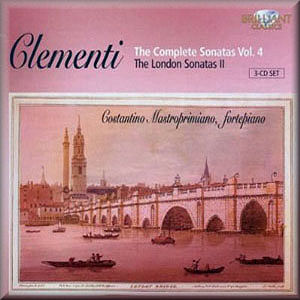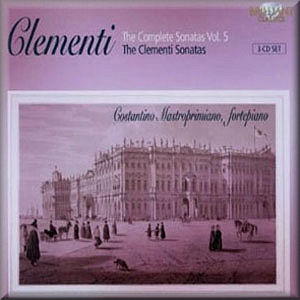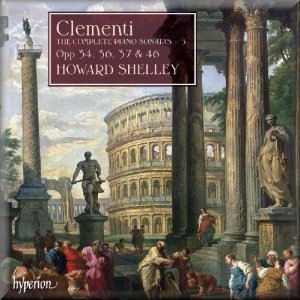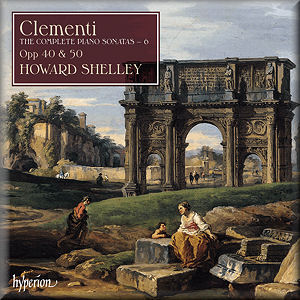 |
 |
| 

alternatively
CD: MDT
AmazonUK
AmazonUS
|
Muzio CLEMENTI
(1752-1832)
The Complete Sonatas
Volume 4 - London Sonatas II
Sonata in E flat, Op. 23 No. 1 [10:20]
Sonata in F, Op. 23 No. 2 [17:11]
Sonata in E flat, Op. 23 No. 3 [13:00]
Sonata in C, Op. 25 No. 1 [15:29]
Sonata in G, Op. 25, No. 2 [9:27]
Sonata in B flat, Op. 25 No. 3 [10:25]
Sonata in A, Op. 25 No. 4 [16:32]
Sonata in f sharp minor, Op. 25 No. 5 [18:09]
Sonata in D, Op. 25 No. 6 [12:09]
Piano Sonata in F, WoO3 [9:25]
Mr.Collicks Minuet WoO5 [6:53]
Sonata in F, Op. 26 [15:33]
Sonata in A, Op. 33 No. 1 [10:02]
Sonata in F, Op. 33 No. 2 [9:48]
Sonata in C, Op. 33 No. 3 [20:31]
 Constantino Mastroprimiano (Kirckman fortepiano, 1798, a'=430Hz)
Constantino Mastroprimiano (Kirckman fortepiano, 1798, a'=430Hz)
rec. Doopsegezinde, Deventer, Netherlands, November 2008. DDD.
 BRILLIANT CLASSICS 94024 [3 CDs: 65:27 + 66:40 + 62:47]
BRILLIANT CLASSICS 94024 [3 CDs: 65:27 + 66:40 + 62:47] 
|


alternatively
CD: MDT
AmazonUK
AmazonUS
|
Muzio CLEMENTI (1752-1832)
Volume 5 - London Sonatas III
Sonata in C, Op. 34 No. 1 [19:20]
Sonata in g minor Op. 34 No. 2 [21:31]
Capriccio in A, Op. 34 No. 3 [8:15]
Capriccio in F, Op. 34 No. 4 [10:30]
6 Progressive Piano Sonatinas, Op. 36 (complete)
No.1 in C [3:38]
No.2 in G [5:01]
No.3 in C [6:34]
No.4 in F [7:05]
No.5 in G [8:11]
No.6 in D [7:17]
Sonata in C, Op. 37 No. 1 [17:59]
Sonata in G, Op. 37 No. 2 [17:06]
Sonata in D, Op. 37 No. 3 [14:59]
 Constantino Mastroprimiano (Clementi Fortepiano, c.1828, a'=430Hz)
Constantino Mastroprimiano (Clementi Fortepiano, c.1828, a'=430Hz)
rec. Rome, 2009. DDD
 BRILLIANT CLASSICS 94113 [3 CDs: 49:06 + 48:16 + 50:04]
BRILLIANT CLASSICS 94113 [3 CDs: 49:06 + 48:16 + 50:04]
 |


alternatively
CD: MDT
AmazonUK
AmazonUS
|
Muzio CLEMENTI
(1752–1832)
The Complete Piano Sonatas
– 5
Sonata in C, Op. 34, No. 1 [18:31]
Sonata in g minor, Op. 34, No. 2 (1795) [21:57]
Six Progressive Sonatinas, Op. 36 (1797) [37:01]
Sonata in C, Op. 37, No. 1 [15:27]
Sonata in G, Op. 37, No. 2 [13:10]
Sonata in D, Op. 37, No. 3 [14:29]
Sonata in B flat, Op. 46 (1820) [25:43]
 Howard Shelley (piano)
Howard Shelley (piano)
2 CDs for the price of one
rec. St Silas the Martyr, London, 6-9 October 2009. DDD
 HYPERION CDA67814 [77:51 + 67:28]
HYPERION CDA67814 [77:51 + 67:28]  |


alternatively
CD: MDT
AmazonUK
AmazonUS
|
Muzio CLEMENTI (1752-1832)
The Complete Piano Sonatas – 6
Sonata in G, Op. 40 No. 1 (1802) [25:03]
Sonata in b minor, Op. 40 No. 2 [16:04]
Sonata in D, Op. 40 No. 3 [19:17]
Sonata in A, Op. 50 No. 1 (1821) [21:16]
Sonata in d minor, Op. 50 No. 2 [19:15]
Sonata in g minor, Op. 50 No. 3 [25:40]
 Howard Shelley (piano)
Howard Shelley (piano)
2 CDs for the price of one
rec. St Silas the Martyr, London, 1-4 December 2009. DDD.
 HYPERION CDA67819 [60:26 + 66:13]
HYPERION CDA67819 [60:26 + 66:13]  |
| |
This, belatedly, is one of a number of reviews which I was
working on some months ago when my computer crashed. I was reminded
of the importance of backing up regularly – I hadn’t. Fortunately
I had kept a few notes and my friend Geoffrey Molyneux, who
is in any case much more knowledgeable about keyboard instruments
and how to play them came to the rescue with a detailed review
(below). You’ll see that we don’t agree in all respects.
I started with two misconceptions: that Clementi’s music was
interesting mainly in terms of technique and historical importance
rather than content – that it was a slightly, but only slightly
more interesting version of those endless Czerny Studies – and
that there were not too many rival recordings to consider. I
see that Geoff Molyneux also shared my first misconception;
in the event we both enjoyed these recordings more than we expected.
Now I wonder if slogging through all those Studies has prejudiced
me unjustly against Czerny, too.
It’s not even the case that these are the only sets of complete
recordings in progress or completed: there’s also one from Pietro
Spada, with George Darden in the Duettinos on the Arts label
– 17 single CDs. Nor do the Brilliant boxes offer the only period-instrument
performances: there’s an interesting mid-price Divine Art Diversions
reissue of Peter Katin playing some of the sonatas on a Clementi
square piano. (DDA24113 – see review
and review
of original release on Athene.) Subscribers to the invaluable
Naxos Music Library can listen to Spada and Katin there.
The Brilliant and Hyperion sets under consideration are all
bargains in that the Brilliant boxes are on offer in the UK
at around £8 each and the Hyperions offer two CDs for the price
of one full-price disc, typically around £13. The Hyperion sets
can also be downloaded from hyperion-records.co.uk in mp3 or
lossless sound for £7.99. The Brilliant boxes are not available
for download yet and are not likely to be much less expensive
than the CDs if and when they are. Volume 5 of the Brilliant
set is actually less of a bargain than it may seem: the content
of the three CDs could easily have been accommodated on two,
whereas all the Hyperion discs are well filled.
Clementi became a maker of fortepianos as well as composer,
teacher – most notably of John Field, inventor of the Nocturne
– and performer, so it’s especially significant that Volume
5 should be performed on an instrument of his own manufacture.
Though a lover of period instruments in general, including the
harpsichord, I have to confess to being somewhat averse to the
sound of the fortepiano but I’m glad to make exceptions, as
in the case of the series of recordings of Beethoven Piano Concertos
with Arthur Schoonderwoerd and the Cristofori Ensemble on Alpha
(ALPHA079, 122 and 155) which I’ve found
to be a genuine revelation.
Thus, while the Kirckman instrument on Volume 4 does not much
appeal to me, Clementi’s own on Volume 5 strikes me as a great
improvement and proved no deterrent to my enjoyment of the music.
In that respect Howard Shelley’s performances on a modern piano
are less instructive, though excellent in their own right. You’ll
find my reasons for generally preferring the Hyperion performances
briefly enumerated in my August 2011/1 Download Roundup here.
You’ll also find there my thoughts on a selection of Clementi
sonatas performed by Nikolai Demidenko on a budget-price Hyperion
Helios CD (CDH55227). The final volume of the Shelley series,
the Capriccios and Variations, to which I referred there was
duly released in September 2011, but I have not yet got round
to listening to it.
Op.34/2 is generally acknowledged as one of the most striking
of these sonatas, approaching at times the intensity of Haydn’s
Sturm und Drang manner, perhaps because it seems originally
to have been composed as a symphony. Mastroprimiano is a little
faster than Shelley in all three movements; there isn’t much
in it but the overall effect is of lightness and virtuosity.
Shelley certainly matches the virtuosity but those extra few
seconds throughout and the use of the modern grand piano make
for greater intensity, his largo for the opening of the
first movement is a touch more sostenuto and his following
allegro has a degree more fuoco.
Tanya Bannister (piano) on Naxos 8.557443 takes 8:38 for the
first movement of Op.34/2, faster than Shelley (8:48) or Mastroprimiano
(8:39), while Pietro Spada (piano), at 9:19, turns in the longest
account of the first movement of any that I have compared (Arts
47233-2). Far from making the opening largo come across
as sostenuto, Spada makes it sound dragged out and his
tempo for the rest of the movement is a little too slow to display
real fire. Bannister offers a copy-book account of the printed
music but, by comparison with the others sounds merely dutiful.
I’m sure I’d have been happy with either Spada or Bannister
heard alone – like David Blomenberg who thought Bannister overall
highly competent and assured (see review)
– but the comparison points the superiority of the Mastroprimiano
and, especially, the Shelley recordings.
Both booklets contain helpful notes but those by Leon Plantigna
for Hyperion are more detailed than and superior to Mastroprimiano’s
own for Brilliant, apart from the illustration in the Brilliant
Volume 5 booklet of Clementi’s improved hammer action. The Brilliant
booklet and website incorrectly describe Op.34/2 as in G when
it is actually in g minor.
Brian Wilson
***
One tends to think of Clementi as an important figure in the
history of early piano manufacture, as a great keyboard virtuoso
rivalling Mozart, and as a composer of pleasant little pieces
for children to play. These sets of CDs of Clementi’s keyboard
music make us think again. Much of his music does seem formulaic,
if I dare say so, in a similar way to that of Vivaldi. These
performances made me realise that there is much more to Clementi
than that.
In Volume 4 Mastroprimiano uses a Kirckman fortepiano of 1798.
This instrument is capable of much tonal variety and expression
as exemplified in the second movement, Adagio, of Sonata
Op. 23 No.2, which is beautifully played with appropriate rubato.
In Op. 23 No.3, after the opening Allegro, the second
movement is an air with variations. The simple theme is developed
in a variety of ways, and Mastroprimiano makes excellent use
of his instrument’s ability to vary tone colour and dynamics.
Even in the final bars we hear a new sound with the concluding
explosive chords.
Three of the six sonatas of Op. 25 have three movements, the
others only two. Op. 25 No.1 in C begins with a vigorous movement,
very difficult to play with the clarity achieved so tellingly
by Mastroprimiano. In the second movement Adagio he produces
a superb tone. The Rondo: Presto finale is played with
brilliance and virtuosity, a very exciting performance. Mastroprimiano
captures the charm and wit of the first movement of No.3, though
the second movement does seem to me to be a rather trivial offering.
No.4 in A has a more substantial opening movement, marked Maestoso
e cantabile. It seems to look forward to early Romantic
piano music with its filigree decorations, gentle chromaticism
and cross-rhythms. Mastroprimiano plays with an appropriate
sense of rubato.
Sonata No.5 in the minor key is a convincing work too, with
its darker moods and a genuine sense of pathos in the Lento
e patetico second movement. The ensuing Presto is
rich in colour with its striking use of thirds. Whilst No.6
has an attractive Un poco andante, the following movement
is a typical Clementi Rondo, somewhat uninspiring.
The Minuet a Tempo di Ballo is a charming set of five
variations on a theme. The work demonstrates ever-increasing
difficulty for the player, as well as giving a lesson in imaginative
variation writing.
Perhaps the most important works in Volume 4 are the three sonatas
Op. 33, composed in 1794. No.1 has two movements, the first
of which is quite lengthy and inventive. After the A major beginning
and bright character of the exposition, Mastroprimiano changes
the mood convincingly as the development moves forward in a
minor key. Now we feel we are hearing an early Romantic period
work. A lively performance of the Presto finale follows.
The first movement of No.2 begins with a poignant Adagio
in a slow basic pulse, but the music soon erupts into rapid
runs of demisemiquavers. The ensuing Allegro con fuoco is
a piece with many unexpected twists and turns of harmony and
phrasing. In this and the Presto second movement, there
is much opportunity for Mastroprimiano to demonstrate his dazzling
virtuosity. No.3 sounds very orchestral and may well be a transcribed
piano concerto. Similarly, the two sonatas of Op. 34 in Vol.5
may be piano transcriptions of orchestral works. The second
movement of Op. 33 No.3 is marked Adagio e cantabile con
grand’espressione’, and Mastroprimiano plays it with due
grandeur and eloquence.
In Volume 5 Mastroprimiano uses a Clementi fortepiano of 1828.
The Sonata in G minor Op. 34 No.2 is a very fine work, reminding
us of how Mozart used that key so effectively. The piece begins
with a Largo e sostenuto which sets a tragic tone, and
this is followed by an Allegro con fuoco which uses and
develops the same motif, with much dissonance, chromaticism
and counterpoint. In this movement maybe Howard Shelley’s modern
instrument scores over Mastroprimiano’s version because of its
ability to sustain the opening slow music. Howard Shelley plays
this movement with appropriate bravura and subtle rubato. However
Mastroprimiano also gives an excellent performance though today
I have a preference for Shelley. The second movement, marked
Un poco adagio is beautifully played by Mastroprimiano,
but once again Shelley can produce a much more sustained tone
on his modern piano albeit in a more romantic style. The final
Molto allegro is played with appropriate virtuosity by
both players. So if you still think of Clementi as a rather
minor composer, have a listen to this. Definitely a piece worth
getting to know, I would say!
The six sonatinas that comprise Op. 36 are pedagogical pieces,
still used to great effect by teachers and their students today.
They are tuneful, full of character and rhythmic vitality, and
they serve their purpose admirably. In the first movement of
Op. 36 No.1 Mastroprimiano’s instrument has an almost explosive
quality in the staccato playing. He is not quite as fast as
Howard Shelley on the modern piano, who discovers wit and humour
in this movement. I like Shelley’s seemingly spontaneous ornamentation
in the repeats in the second movement. In Op. 36 No.4, Shelley
brings out the sadness and pathos in the Andante con espressione
second movement in a quite slow performance. Mastroprimiano
starts slowly gradually moving forward, but the mood is more
of quiet contemplation. In the fast movements, his Clementi
fortepiano is well able to cope with the clear articulation
necessary, particularly at such high speeds. However we do hear
a few characteristic twangs now and then which either add to
the charm or irritate you depending on your reaction to the
sound of these early keyboards.
Mastroprimiano plays the first movement of Op. 37 No.1 with
beautiful tone and touch making subtle use of the new damper
mechanism available on Clementi’s instruments. Shelley plays
this movement, and many others, considerably faster than Mastroprimiano,
and he displays stunning passagework with great variety in his
articulation. However Mastroprimiano and his instrument give
us a much clearer insight as to how these works may have sounded
in Clementi’s day. They make Shelley’s performances seem very
inauthentic and a little artificial, but maybe this is only
an impression I get because I heard the Mastroprimiano first!
In the finale of Op. 37 No.3, Mastroprimiano’s fractionally
slower tempo allows more breathing space and greater clarity.
His period instrument makes the special blurry effect of the
‘open pedal’ very telling. The tonic pedal below the main rondo
theme sounds like bees buzzing around in a bag. The modern piano
version seems a bit tame after that.
In many ways Clementi’s sonatas are more difficult to play than
Mozart’s. Although Mozart had no time for Clementi, Beethoven
greatly admired him and there is no doubt that Clementi had
a great influence on the early Romantic composers. Clementi
was interested in developing a real legato style of playing
on his newly built keyboard instruments. Much of Clementi’s
music is inspired, often beautiful, sometimes dramatic and frequently
virtuosic. If I had to choose between the two versions I would
go for the Mastroprimiano whose performances really show us
how these pieces might have sounded in Clementi’s day, with
great variety and clarity of texture and telling articulation.
Shelley’s performances are also excellent, so buy these if you
prefer the more romantic sound of the modern piano in these
works.
Geoffrey Molyneux
see also review of Hyperion v5 by Mark
Sealey
|
|

